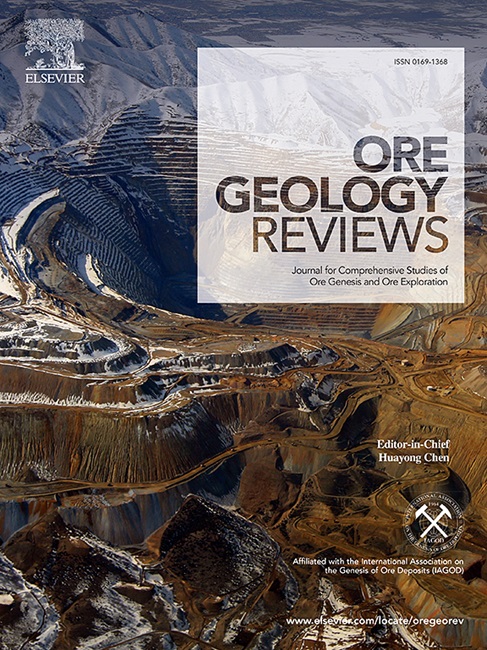Geology and genesis of gold deposits in the daduhe belt: A Case study of the Lianhua gold deposit on the Western margin of the Yangtze Craton, China
IF 3.2
2区 地球科学
Q1 GEOLOGY
引用次数: 0
Abstract
The Daduhe gold belt (DGB) is an essential gold mineralization belts discovered in southwestern China. However, there are still some controversies on the material source, fluid origin and properties. The Lianhua gold deposit, as one of the typical gold deposits in the DGB, is suitable to understand the mineralization. Based on field investigation, and analysis on mineralogy, fluid inclusions, and S-H-O isotope geochemistry, a possible metallogenic model is proposed. According to field observations, the Lianhua deposit has experienced at least two phases of hydrothermal activity, namely, the ore-forming and post-ore periods. Three types of fluid inclusions are identified: 1) VCO2–LH2O (C1 type), 2) VCO2±CH4–LH2O (C2 type), and 3) VH2O–LH2O (W type). The inclusions in ore-forming periods are mainly C1 and C2 type, while the post-ore period is W type predominately. Microthermometric analyses show that ore-forming quartz veins formed in a low to medium temperature (201.6℃–315.2℃), low to medium salinity (3.05–13.20 wt% NaCl eqv.) H2O–NaCl–CO2 ± CH4 system. The H-O isotope of ore-forming quartz shows, the δ18OV-SMOW ranged from 7.29 ‰–10.81 ‰, whereas the δDV-SMOW ranged from − 63.5 ‰–−68.3 ‰, implying that the ore-forming fluids are formed by a mixture of metamorphic fluids and meteoric water. Fluid immiscibility caused by the separation of CO2 ± CH4–H2O system and H2O–NaCl system may be the main mechanism of gold precipitation. The δ34S values of pyrite ranged from − 3.12 ‰–5.92 ‰, indicating that the Kangding complex provided ore-forming materials.
The post-ore tourmaline quartz veins formed in a medium to high temperature (286.6℃–460.1℃), medium to high salinity (9.98–20.26 wt% NaCl eqv.) H2O–NaCl system. The δ18OV-SMOW is 9.16 ‰, whereas the δDV-SMOW is − 85.5 ‰, implying that the post-ore fluids are predominantly primary magmatic water or at least vast magmatic water injection. Tourmaline, as a characteristic mineral of post-ore hydrothermal event, is formed by crustal magmatic fluids reacted with the Kangding complex. However, the post-ore magmatic-hydrothermal fluids did not contribute to the enrichment of gold in the Lianhua deposit.

求助全文
约1分钟内获得全文
求助全文
来源期刊

Ore Geology Reviews
地学-地质学
CiteScore
6.50
自引率
27.30%
发文量
546
审稿时长
22.9 weeks
期刊介绍:
Ore Geology Reviews aims to familiarize all earth scientists with recent advances in a number of interconnected disciplines related to the study of, and search for, ore deposits. The reviews range from brief to longer contributions, but the journal preferentially publishes manuscripts that fill the niche between the commonly shorter journal articles and the comprehensive book coverages, and thus has a special appeal to many authors and readers.
 求助内容:
求助内容: 应助结果提醒方式:
应助结果提醒方式:


